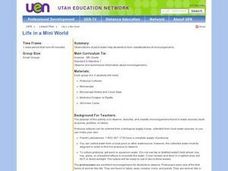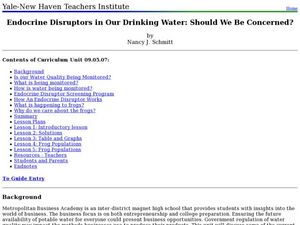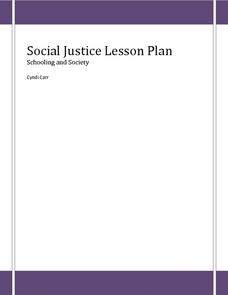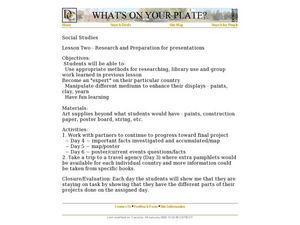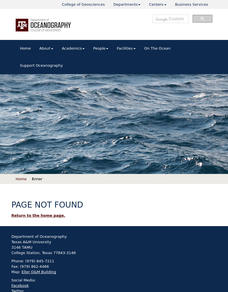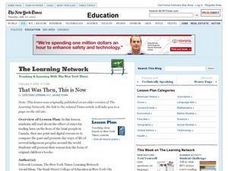Curated OER
Ancient River Civilizations
Young scholars investigate the growth of the Ancient River Civilizations. In this world history lesson, students compare and contrast ancient and modern maps of the area of river civilizations.
Curated OER
How Much Is There To Eat?
Tenth graders compare the relationship of food production and population in India with the southern regions of the United States.
Curated OER
Why are People Hungry and Malnourished?
Students read "The Story of Miguel's Tomatoes" to review the steps involved in the food system. In groups, students complete a food system chart. Using the chart as a model, students choose a commonly eaten food and trace it from its...
Curated OER
How Did That Get in My Lunch?
Young scholars view "The Danger Zone" to learn about food poisoning and the bacterial causes and prevention. Students look at slides, use a worksheet, "Microbial Bugs"and the internet to identify and learn about each bacterium.
Curated OER
Life in a Mini World
Sixth graders observe, describe, and classify microorganisms found in water sources. In small groups, they make their own slide, observe the Protozoa under a microscope, and record and classify the microorganisms.
Curated OER
LIONS and TIGERS and BEARS. . .Oh My! Animals of Connecticut and the World
Students identify and list the different types of pets owned by the children in the class.
They graph the total number of each type of pet owned. They draw or cut-out a picture of an animal. Using the materials listed above, the children...
Smithsonian Institution
Cold War
The Cold War was not necessarily always cold in temperature, but the relationship between the United States and the Soviet Union sure was frigid! Scholars read various passages, view exhibition graphics, and observe an artifact from the...
Curated OER
Spaceship Earth
Students study the earth as a system, and the fragility of that system when population, and pollution, are considered as interactive parts of earth.
Captain Planet Foundation
George Washington Carver and the Sweet Potato
Learn about George Washington Carver's important contributions to agriculture by studying the sweet potato. First graders read about the inventor's observations and prepare sweet potato slips for the class garden. Additionally, they...
Curated OER
Explorit's Green Salad Quiz
In this food history worksheet, students read the information about the history of food and salads. Students select the correct answer for the 6 related questions.
Curated OER
Endocrine Disruptors in Our Drinking Water: Should We Be Concerned?
High schoolers investigate the different hormone contaminants in the water supply. In this math lesson, students analyze data tables and graphs. They demonstrate exponential growth and decay using frog populations.
Curated OER
Topography of Africa
Students study Africa's diverse landscape and investigate how these features impact the available water supply, food sources, and population distribution of the continent. They compare topographical features and
their affect on each...
Curated OER
Jr. Chef Club Making Brainy Breakfasts
Young scholars identify the benefits of eating a nutritious breakfast. In this nutrition activity, students read food labels to identify foods that are low in sugar. Young scholars create a healthy breakfast by using eggs and low-fat...
Curated OER
A Small Book of Small Things
Students explore size relationships as they collect pictures of the small things in their world. In this early childhood math and literacy lesson, students gain an understanding of size differences and develop fine-motor and literacy...
Curated OER
Social Justice-Water in Developing Countries
Students explore how water shortage affects everyday life. In this social justice activity, students discuss information about water shortage in Ghana. A water shortage simulation/game is played in which a "Canadian" team starts with a...
Curated OER
Too Cool for School-The Greenhouse Experiment
Students create a town model and analyze the type of greenhouse gases their town emits. In this earth science lesson, students build greenhouses to investigate how trapped heat causes temperature change. They relate this activity to...
Curated OER
Dry-Land Kalo-Growing New Plants from Stems
Students explore Hawaiian plants. In this Hawaii culture and botany lesson plan, students plant the haha(stem) of a taro plant. Students listen to Hawaiian myths about the taro plant and chorally speak a Hawaiian chant of protection....
Curated OER
What's on Your Plate? Lesson 2
Students research countries of the world. In this global studies instructional activity, students discover details of cultures in the world as they become experts on selected countries. Students create posters and brochures that feature...
Curated OER
The Cold War: Chapter 9: Lesson 1
Used as a quick review of the Cold War, Korean War, and Cuban Missile Crisis, this presentation could be in many scenarios. However, the graphics and question types seem more appropriate for younger students, while the content is geared...
Perkins School for the Blind
Mixtures and Solutions
Mixtures and solutions are different; one can be separated fairly easily and the other cannot. This hands-on experiment was written specifically for learners with visual impairments or blindness. They will use lemonade and trail mix to...
Polar Trec
Plankton Parents
Plankton are so abundant in the ocean they outweigh all of the animals in the sea. In this three day activity, groups discuss and become familiar with plankton, capture females, and look for egg production on day three.
Curated OER
What's In Your Grocery Bag?
Young scholars explore the global implications of consumer decisions when purchasing groceries. They examine labels of food products and discuss the wording on the labels. They calculate food miles of how far each ingredient in foods...
Curated OER
Fisheries
Students research and report on the ocean's problems of disappearing or diminishing species around the world. students examine ecosystems and food chains and present their findings to a mock panel of science experts.
Curated OER
That Was Then, This Is Now
Learners examine the price of food over time. They analyze charts, perform math operations and compare and contrast data about the price of food. They complete worksheets while interperting the charts.




